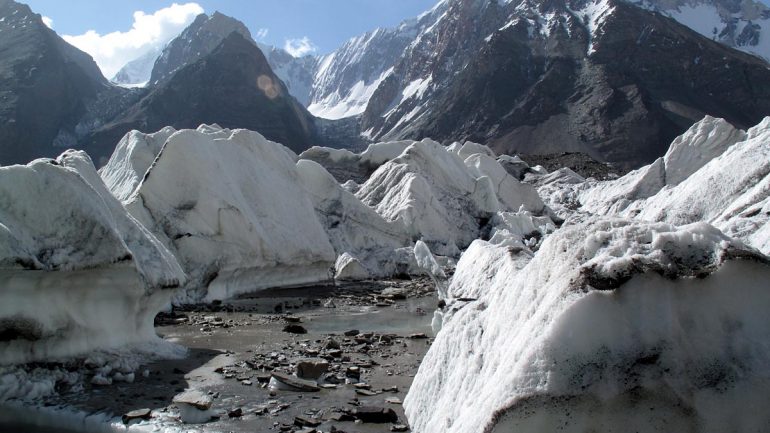GLACIERS OF TAJIKISTAN: THE SOURCE OF CENTRAL ASIAN WATER AND THEIR PROTECTION

- Автор apatj
- Категория - Новости академии
Experts claim that while glacier melting is a natural process, it has recently accelerated relative to the pre-industrial age.
19 of the more than 8,000 glaciers in Tajikistan are big. They help feed the republic’s major rivers and provide fresh water during the warmest summer days, which is crucial for Tajikistan as well as other countries in the region of Central Asia. Some sizable glaciers have receded by kilometers in recent decades as a result of climate change. According to scientists, glacier melting is essentially irreversible and has only gotten faster since the industrial revolution.
The majority of the glaciers in Central Asia are found in Tajikistan. Just 6-8% of the nation’s land (8,476.2 square kilometers) is covered by glaciers, yet they nonetheless contain hundreds of cubic kilometers of pure water. The majority of the glacier is concentrated in the area around the Somoni and Abu Ali ibn Sino peaks, which are the highest points in the republic.
Massive glaciers in Tajikistan provide water for the Amu Darya and Zeravshan river systems, which flow into Uzbekistan, Turkmenistan, and Kazakhstan downstream. As a result, it is common knowledge that Tajikistan is where the majority of the water in the area is produced.
The greatest glaciers in Central Asia are found in Tajikistan. Glaciers that originate on the Somoni peak’s slopes rise to a height of 7,400 meters above sea level, according to the “Center for the Research of Glaciers of Tajikistan,” although those that originate in the Surkhob and Kafirnigan river basins rarely rise higher than 4,500–5,000 meters. The tallest mountains in Tajikistan—Akademiya Nauk, Darvaz, Peter the Great, Vanch, and Yazgulem—join to form a glacial knot, which is home to the country’s greatest glaciers. It is where Fedchenko, the largest glacier in Central Asia, begins. The republic is home to 18 different types of glaciers, the majority of which are found in the east of the nation.
The Gorno-Badakhshan Autonomous Region of Tajikistan is home to Fedchenko Glacier. The glacier is among the ten largest in the world and is the longest outside of the polar regions. It has 50 tributaries, some of which are the biggest glaciers in Central Asia, covering an area greater than 30 square kilometers. Glaciers from the Academy of Sciences, by Bivachny, Nalivkin, and Vitkovsky. Including all of its tributaries, Fedchenko Glacier covers 651.7 sq km of land and reaches a maximum length of 77 km. The Fedchenko Glacier system consists of a total of 45 glaciers.
Tajik climatologists evaluated how the country’s glaciers will fare under a changing climate. Observational data show that since 1930, the republic’s entire glacier area has shrunk by around 30%.
The average annual temperature in the republic, both in the valleys at an altitude of 1000 meters above sea level and in the mountains at an altitude of 2500 meters and above, has increased over the past 70 to 80 years, according to the Agency for Hydrometeorology of Tajikistan, and this has caused the majority of the glaciers to retreat. The highlands, where the majority of the nation’s glaciers and snowfields are found, likewise show this pattern.
A proposal to designate 2025 as the “International Year of Glaciers’ Protection” was proposed by the Republic of Tajikistan on December 14, 2022, during the 77th session of the UN General Assembly. As it concurrently proclaims the International Day and the International Year for the Protection of Glaciers, it is essentially special. With the backing of 153 UN member states, the recent initiative of the Creator of Peace and National Unity – Leader of the Country, President of the Republic of Tajikistan H.E. Emomali Rahmon, has been adopted.
It should be noted that the Leader of the Nation, President of the Republic of Tajikistan H.E. Emomali Rahmon, spoke about the rapid melting of glaciers along with an increase in water consumption, which depends on population growth and economic development, may have serious and negative consequences in March 2021 during the first meeting of the Water and Climate Coalition Leaders.
In this regard, the country’s president proposed designating 2025 as the International Year of Glaciers’ Preservation, establishing the International Day of Glaciers’ Preservation, and creating a special trust fund to support initiatives for the preservation of glaciers in order to increase awareness of this crucial issue.
The fact that the proposals made by the President of the Republic of Tajikistan and the by the UN member states on the basis of this resolution is an important aspect.
- Designating March 21 as the International Day for the Preservation of Glaciers;
- naming 2025 the International Year for the Preservation of Glaciers;
- establishing a UN Trust Fund to support initiatives for the Preservation of Glaciers;
- hosting the International Conference on the Preservation of Glaciers in Dushanbe in 2025.
In the resolution, it is emphasized how crucial glaciers are to the hydrological cycle and the significant effects that their accelerated melting is having on the climate, the environment, human health, and sustainable development.
A new worldwide effort to take the essential coordinated activities to safeguard glaciers from rapid melting and disappearance will undoubtedly receive a significant boost from the initiative to designate 2025 as the International Day of Glaciers’ Preservation.
In order to take the necessary actions and carry out tasks, it will be easier to gather financial resources from diverse sources with the development of an international trust fund under the UN to support the preservation of the glaciers. These programs naturally fit into the overall framework of the actions being done by the international community in accordance with the Paris Agreement to reduce carbon dioxide emissions into the atmosphere and stop global temperatures from rising above 2.0 °C.
The unanimous approval of the resolution attests to the significance and applicability of this effort as well as the President of IFAS, H.E. Emomali Rahmon, of the Republic of Tajikistan, who has successfully promoted water and climate issues on the international agenda.
Khizmatbibi SAIDRAHMATZODA,
master’s degree of Academy



